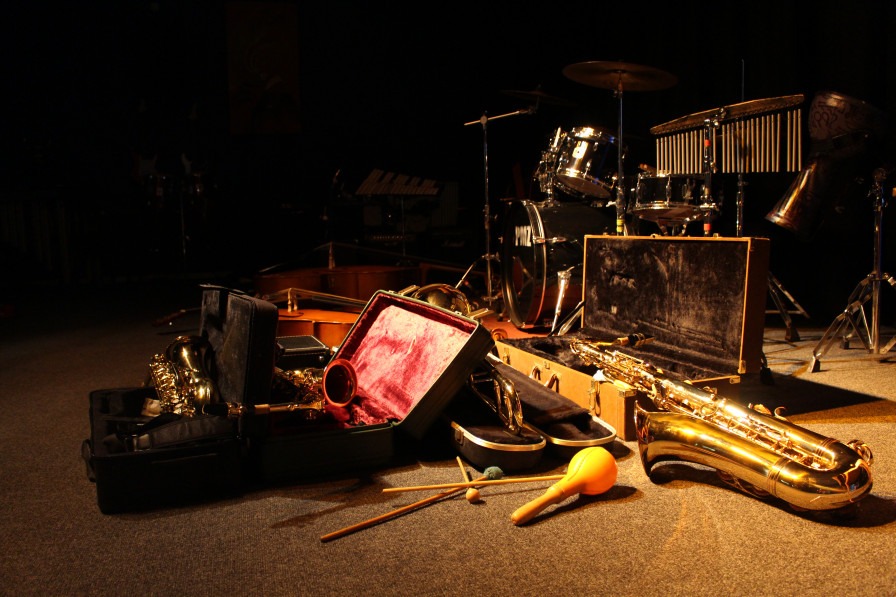Soundpainting at Plymouth Music Zone - drawing on an idea!

Hi and welcome to my first ever blog post! To be honest this is probably something that I’d thought I’d never do being of an age where ’blogging’ seems like a relatively new thing. I’m sure there will be other clues to my age group that could be fathomed as I go on. The reason for this post is to share a method within workshop practice that I have found incredibly flexible and useful for a wide range of settings.
I went to university as a mature student to fill in some of the areas of music that a self-taught working bassist doesn’t get the chance to cover. One of the most interesting areas I ‘discovered’ was the late sixties experimental pioneers including Philip Glass, Terry Riley and Steve Reich. With a BA in music achieved just before turning 50, I continue this line of study which has led me to 'Soundpainting' and the work of Walter Thompson.
http://www.soundpainting.com/ describes the practice as:
Soundpainting is the universal multidisciplinary live composing sign language for musicians, actors, dancers, and visual Artists. Presently (2019) the language comprises more than 1500 gestures that are signed by the Soundpainter (composer) to indicate the type of material desired of the performers. The creation of the composition is realized, by the Soundpainter, through the parameters of each set of signed gestures. The Soundpainting language was created by Walter Thompson in Woodstock, New York in 1974.
I’ve been a Music Leader at Plymouth Music Zone (PMZ) for some 15 years now gaining experience in the full breadth of community music. Despite focusing recently on the health and social benefits of singing with older people, I still occasionally get the chance to work with ‘youngsters’.
Plymouth Music Zone’s (PMZ) ‘Breakthrough Music’ Youth Music funding combined with Arts Council England’s NPO (National Portfolio Organisation) funding this year has prompted and enabled us to think about new ways of working creatively with our participants. 20 students from our local further education college 'City College Plymouth' Skills Development course students (aged 16-19) have been working with me over 10 weeks as part of this funding as well as 4-5 support / teaching staff.
Aside from an enjoyable creative experience, the college finds it hugely valuable that the sessions contain a strong focus on soft skills such as sharing, turn taking, listening and leading. In previous years, sessions have consisted of a mixture of exploring repertoire (cover songs), bits of conducting and the introduction of basic musical skills such as pulse, counting, and dynamics. The soft skills naturally happen as the students evolve into an ensemble. Students gain confidence and empowerment as they conduct with song choice and creation of conducting gestures building a sense of group ownership.
With 'Soundpainting' I feel I have for the first time found a way to push the improvisational part of the session to the forefront of the work culminating in a product and performance rather than just focusing on the benefits of the process. The idea was reinforced by my attending the South West Peninsula Music Hub Conference at Buckfastleigh in Spring 2019 where facilitator, Vincent Touret led a Soundpainting demonstration session purely using voice and body percussion.
Obviously 1500 visual commands is a lot to get through. So I needed to adapt the system by taking only a few aspects of its four categories: Who? With what? When? How? that covered start / stop, volume, pitch, tempo and duration, etc. Participants are free to use any note they can produce following simple clear commands that are gradually introduced and reinforced as the weeks go on. This scaffolded approach builds confidence to try new things and allowed space to make mistakes in a safe way. This said, there have been challenges, as Schoenberg said we really are ‘emancipating the dissonance’ here, but there are enough instances of beauty to make it worthwhile.
Some key outputs from using the system in this work were:
- Standardisation of conducting commands and how to understand their functions
- Achievement: a sense of building something of substance together in a relatively short timespan
- Improvement: an opportunity to notice developing skills weekly
- Ownership
- Different learning styles catered for
- Leadership
- Soft Skills
- Improvisation
- Challenging perspectives of group-based music
- Understanding basic building blocks of music
- Capacity to extend learning
- Introduction to musical instruments and sections that make up an ensemble
- Opportunities for performance and recordings
Looking Forward...
With Plymouth Music Zone in its 20th year we are looking at how we can bring together our groups, young and old, all abilities for one large musical event. This method of standardising the group understanding of conducting signals and sharing the approach with my Plymouth Music Zone colleagues offers the opportunity to bring together all of our disparate groups for one glorious noise.
More information about Soundpainting can be found at: http://www.soundpainting.com
Many thanks to Plymouth PMEH (Plymouth Music Education Hub) for supporting the training at the conference and to Vincent for getting me thinking about ways of using the approach!
